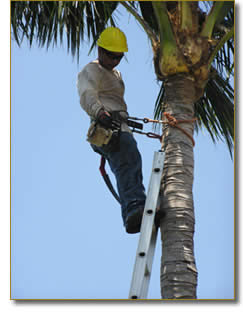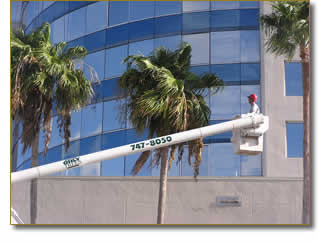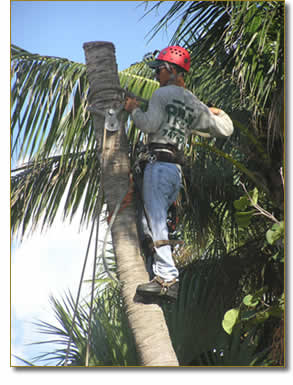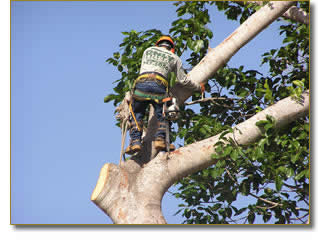|
The Value of Your Trees:
Almost everyone knows that trees and other living plants are valuable. They help beautify your surroundings, purify the air, act as a sound barrier, manufacture oxygen, and help you save energy through their cooling shade in summer and their wind reduction in winter. However, many people don't realize that plants have a dollar value of their own that can be measured by competent plant appraisers. If your trees or shrubs are damaged or destroyed, you may be able to recapture your loss through an insurance claim or as a deduction from your federal income tax.
If you suffer damage to trees or landscaping from any type of casualty, first consult your homeowner's insurance policy to determine the amount and kind of coverage. Contact the insurance company to arrange for them to have an appraisal made by a competent tree and landscape professional who is experienced in plant appraisal. Have the appraisal made right after your loss or damage.
The following checklist can improve the value of your investment and prevent financial loss if they are damaged or destroyed:
-
Plan your landscaping for both beauty and functional value.
-
Protect and preserve to maintain value.
-
Take pictures or your trees and landscape plants when they are healthy and vigorous. This makes before and after comparisons easier and will expedite the processing of insurance and/or IRS claims.
-
Check your insurance. In most cases, the amount of an allowable claim for any one tree is a maximum of $500.00.
-
Keep accurate records of your landscape appraisals and real estate appraisal in case of any loss.
-
Consult your local plant health care expert at every stage in the life of your trees - planning, planting and when a casualty or loss strikes to make sure you do not suffer needless financial loss.
Back to Top
Factors in Professional Evaluation of Your Trees:
-
 Tree size. Sometimes the size and age of a tree are such that it cannot be replaced. Trees that are too large to be replaced should be evaluated by professionals who use a specialized appraisal formula. Tree size. Sometimes the size and age of a tree are such that it cannot be replaced. Trees that are too large to be replaced should be evaluated by professionals who use a specialized appraisal formula.
-
The kind of tree (its classification). Choose the species for its utility and its adaptability. Tree values vary according to your region, the hardiness zone and even state and local conditions. If you are not familiar with these variables, be sure your advice comes from a competent source. Trees which are hardy, durable, highly adaptable and free from objectionable characteristics are worth the most. They require less maintenance, they have sturdy, well-shaped branches and pleasing foliage.
-
Condition of the tree, shrub or plant. The professional will also consider the condition of the tree. Obviously, a healthy, well-maintained tree will have a higher value. Roots, trunk, branches and buds need to be inspected before determining tree condition.
-
Location of the tree. There are functional considerations as well as aesthetic. This is where location enters into the evaluation. A tree in your yard may be worth more than one growing in the woods. One standing alone will often value higher than one in a group. A tree near your house or one which is a focal point in your landscape tends to have more value. The site, placement and contribution of a tree helps to determine the overall value of the tree attributable to location.
Back to Top
Benefits of Trees:
Most trees in cities or communities are planted to provide beauty or shade. These are two excellent reasons for their use. Trees also serve many other purposes and it is often helpful to consider these other functions when selecting a tree for your landscape.
-
 Social Benefits -
People like trees around them because they make life more pleasant. Most of us respond to the presence of trees beyond simply observing their beauty. The strong ties of people and trees are most evident in the resistance of community residents to removing trees to widen streets, or we note the heroic efforts of individuals and organizations to save particularly large or historic trees in the community. Trees can make us feel serene, peaceful, restful and tranquil. Social Benefits -
People like trees around them because they make life more pleasant. Most of us respond to the presence of trees beyond simply observing their beauty. The strong ties of people and trees are most evident in the resistance of community residents to removing trees to widen streets, or we note the heroic efforts of individuals and organizations to save particularly large or historic trees in the community. Trees can make us feel serene, peaceful, restful and tranquil.
-
Community Benefits -
City trees often serve several architectural and engineering functions. They provide privacy, emphasize views or screen out objectionable views. They reduce glare and reflection. They direct pedestrian traffic. They provide backgrounds, or soften, complement or enhance architecture. Trees bring natural elements and wildlife habitats into urban surroundings; all of which increase the quality of life for residents of the community.
-
Environmental Benefits -
Trees alter the environment in which we live by moderating climate, improving air quality, conserving water and harboring wildlife. Climate control is achieved by moderating the effects of sun, wind and rain. Trees intercept water, store some of it, reduce storm run-off and the possibility of flooding. The leaves of trees filter the air we breathe by removing dust and other particulates. Leaves also absorb other air pollutants such as ozone, carbon monoxide and sulfur dioxide, and give off oxygen. By planting trees, we return to a more natural and less artificial environment and natural harmony is restored to the urban environment.
-
Economic Benefits -
Property values of landscaped homes are 5-20% higher than those of non-landscaped homes. The economic benefits of trees can be both direct and indirect. Direct economic benefits are usually associated with energy costs. Air conditioning costs are lower in a tree-shaded home. Heating costs are reduced when a home has a windbreak. Trees increase in value from the time they are planted until they mature. Trees are a wise investment of funds since landscaped homes are more valuable than non-landscaped homes. The indirect economic benefits of trees are even greater and effect the community or region. To the individual these savings are small, but to the community, reductions in expenses, due to trees in the landscape are, often in the thousands of dollars.
Back to Top
Helpful Links:
(note - these links will open in a new window, simply close that window to return here)
Florida Chapter of the International Society of Arboriculture
International Society of Arboriculture
Trees Are Good
Tree Care Industry Association (TCIA)
Florida Department of Environmental Protection - Mangrove Facts
Florida Department of Environmental Protection - Mangrove Coordination
The National Arbor Day Foundation
Back to Top
Hurricane Preparation:
When a major storm strikes, some trees seem to be able to come through with only minor damage, while others suffer the loss of large limbs or sizable parts of their branching structure. In the worst cases, trees may be completely split in two or may have nothing left standing but a trunk.
If a tree has been weakened by disease, there may be little that can be done to prevent major breakage or loss when the stresses of a storm occur. However, there are preventive measures that home and property owners can take to help their trees be stronger and more resistant to storm damage.
The National Arbor Day Foundation offers these five suggestions for pruning a tree that will promote the growth of strong branches:
-
Encourage good branch angles. For most deciduous (broadleaf) trees, narrow angles between branches signal a point of future weakness, whether in the trunk or in the crown of the tree. This happens because as two branches grow closely together, neither has sufficient space to add the wood needed for strength. Instead, they grow against each other, creating a weak joint. The effect is similar to hammering in a wedge between them.To prevent this, remove one of the two branches when the tree is young. For best branch strength, the ideal branching angle in many broadleaf tree species approximates 10 o'clock or 2 o'clock. Branches at those angles should be encouraged by removing competing but less desirable neighbors.
-
Encourage strong branch/trunk size relationships. The relative size of lateral (side) branches is also important in determining branch strength. Ideally, lateral branches should be no more than 1/2 to 3/4 the diameter of the trunk. Branches larger than that are often heavier than the trunk can support, and are candidates to break when wind, ice, or snow come along. Trees grow by adding new layers of wood on the trunk and branches each year. As the trunk grows, it will strengthen the joints with branches by adding wood around it, like a dowel in a chair leg.
-
Maintain a stable center of gravity. Wind, winter snow loads, or previous loss of a major limb can create situations where the tree's center of gravity is not positioned over the trunk. Then when a severe storm hits, a slight bit of extra weight or wind pressure can break limbs, snap the trunk off, or even topple the tree, roots and all. You can help reposition a tree's center of gravity by selectively removing branches on the leaning side and encouraging branches on the opposite side.
-
Remove rubbing branches, suckers, watersprouts, and temporary branches. Branches that rub against each other produce wounds and decay. One of the offending branches should be removed. Watersprouts and suckers can occur at the base of the tree or inside the crown. They are rapidly growing, weakly attached, and upright branches that do not follow the tree's normal growth pattern. On trees that have been severely damaged, these kinds of branches may be temporarily needed to provide foliage. In healthy trees, however, they most often use more energy than they return to the tree, and it is best to remove them as soon as possible.
Temporary branches grow low on the tree when it is young and protect young bark from injury by the sun. After a tree is three to four years old, these temporary branches should be gradually removed.
Because leaves are vital in providing the tree with nourishment, never remove more than one-third of a tree's leafy crown when pruning.
- Don't cut branches back to stubs. Often people have the mistaken idea that long natural limbs on a tree will break more easily in a storm, and should be cut back to make them stronger. Just the opposite is the case. When a branch is cut back to a stub, new branches will grow from the edges of the stub. Because they cannot form a strong union with the stubbed branch, these new branches are even more likely to be broken in a future storm. If a branch needs to be removed, cut it back to a main branch or to the tree's trunk. Never leave a stub.
Back to Top
After the Storm:
 In the aftermath of a major storm, the initial impulse of property owners is generally along the lines of “let's get this mess cleaned up.” But hasty decisions can often result in removing trees that could have been saved. In the aftermath of a major storm, the initial impulse of property owners is generally along the lines of “let's get this mess cleaned up.” But hasty decisions can often result in removing trees that could have been saved.
Trees damaged in storms can recover. Storms and gravity combine with defects to damage trees in a variety of ways. Damage is sometimes so severe that restoration is not practical or it is difficult. Trees with less severe damage can be restored to a certain extent.
Some trees that were broken, blown over, or otherwise impacted by storms can be treated. Severely impacted trees need to be cut down and removed. This topic is complicated and retaining the services of a competent arborist is recommended.
Doing the right things after trees have been damaged can make the difference between giving your trees a good chance of survival and losing them unnecessarily. The National Arbor Day Foundation urges home and property owners to follow a few simple rules in administering tree first aid after a storm:
-
Don't try to do it all yourself. If large limbs are broken or hanging, or if high climbing or overhead chainsaw work is needed, it's a job for a professional arborist.
-
Take safety precautions. Look up and look down. Be on the alert for downed power lines and dangerous hanging branches that look like they're ready to fall. Stay away from any downed utility lines - low-voltage telephone, cable lines and even fence wires can become electrically charged when there are fallen or broken electrical lines nearby. Don't get under broken limbs that are hanging or caught in other branches overhead. And, unless you really know how to use one, leave chainsaw work to the professionals.
-
Remove any broken branches still attached to the tree. Removing the jagged remains of smaller sized broken limbs is one common repair that property owners can make after a storm. If done properly, it will minimize the risk of decay agents entering the wound. Smaller branches should be pruned at the point where they join larger ones. Large branches that are broken should be cut back to the trunk or a main limb by an arborist. For smaller branches, follow the pruning guidelines shown in the illustration so that you make clean cuts in the right places, helping the tree to recover faster.
-
Repair torn bark. To improve the tree's appearance and eliminate hiding places for insects, carefully use a chisel or sharp knife to smooth the ragged edges of wounds where bark has been torn away. Try not to expose any more of the cambium (greenish inner bark) than is necessary, as these fragile layers contain the tree's food and water lifelines between roots and leaves.
-
Resist the urge to overprune. Don't worry if the tree's appearance isn't perfect. With branches gone, your trees may look unbalanced or naked. You'll be surprised at how fast they will heal, grow new foliage, and return to their natural beauty.
-
Don't top your trees! Untrained individuals may urge you to cut back all of the branches, on the mistaken assumption that reducing the length of branches will help avoid breakage in future storms. While storm damage may not always allow for ideal pruning cuts, professional arborists say that “topping,” cutting main branches back to stubs, is one of the worst things you can do for your trees. Stubs will tend to grow back a lot of weakly-attached branches that are even more likely to break when a storm strikes. Also, the tree will need all its resources to recover from the stress of storm damage. Topping the tree will reduce the amount of foliage, on which the tree depends for the food and nourishment needed for regrowth. A topped tree that has already sustained major storm damage is more likely to die than repair itself. At best, its recovery will be retarded and it will almost never regain its original shape or beauty
Back to Top
Glossary:
Crown Thinning: When a mature tree becomes densely branched, it can cast too much shade and be susceptible to wind damage. Thinning the branches allows more light to filter to the ground and improves air flow through the foliage.
Crown Reduction: This refers to the method of reducing the height or spread of a tree. Sometimes the crown of a tree must be reduced in height or spread, such as for utility and roof clearance. The key to this method is a pruning technique called "Crotch Dropping", where the upper horizontal branches are removed with a flush vertical trim from the main leader.
Topping: This is the practice of removing most of the canopy, leaving mostly branch stubs. The new growth of a topped tree will come back dense, making the tree more vulnerable to high winds. The effects of topping include: the decay of large, unhealed wounds, insect infestation, sun scald to the bark and in some cases, death of the tree. Tree topping is not good for your valuable trees and is a practice never used by World Wide Tree Service. Most cities and municipalities have deemed the practice of topping illegal and the homeowner can be fined by the city for topping their trees. A topped tree is vulnerable in high winds and can become "missile like" in a storm situation.
Lifting: A pruning practice where lower limbs are specifically trimmed and/or removed to provide clearance for cars, structures or pedestrian traffic, a view of a home or property, etc. The height of the lift is dictated by the height of the tree and is always done in proper proportion. Exceptions to this are power lines or structures which call for job specific lifting.
Back to Top
Call Today (954) 496-6925
|



 Tree size. Sometimes the size and age of a tree are such that it cannot be replaced. Trees that are too large to be replaced should be evaluated by professionals who use a specialized appraisal formula.
Tree size. Sometimes the size and age of a tree are such that it cannot be replaced. Trees that are too large to be replaced should be evaluated by professionals who use a specialized appraisal formula.  Social Benefits -
People like trees around them because they make life more pleasant. Most of us respond to the presence of trees beyond simply observing their beauty. The strong ties of people and trees are most evident in the resistance of community residents to removing trees to widen streets, or we note the heroic efforts of individuals and organizations to save particularly large or historic trees in the community. Trees can make us feel serene, peaceful, restful and tranquil.
Social Benefits -
People like trees around them because they make life more pleasant. Most of us respond to the presence of trees beyond simply observing their beauty. The strong ties of people and trees are most evident in the resistance of community residents to removing trees to widen streets, or we note the heroic efforts of individuals and organizations to save particularly large or historic trees in the community. Trees can make us feel serene, peaceful, restful and tranquil.  In the aftermath of a major storm, the initial impulse of property owners is generally along the lines of “let's get this mess cleaned up.” But hasty decisions can often result in removing trees that could have been saved.
In the aftermath of a major storm, the initial impulse of property owners is generally along the lines of “let's get this mess cleaned up.” But hasty decisions can often result in removing trees that could have been saved.